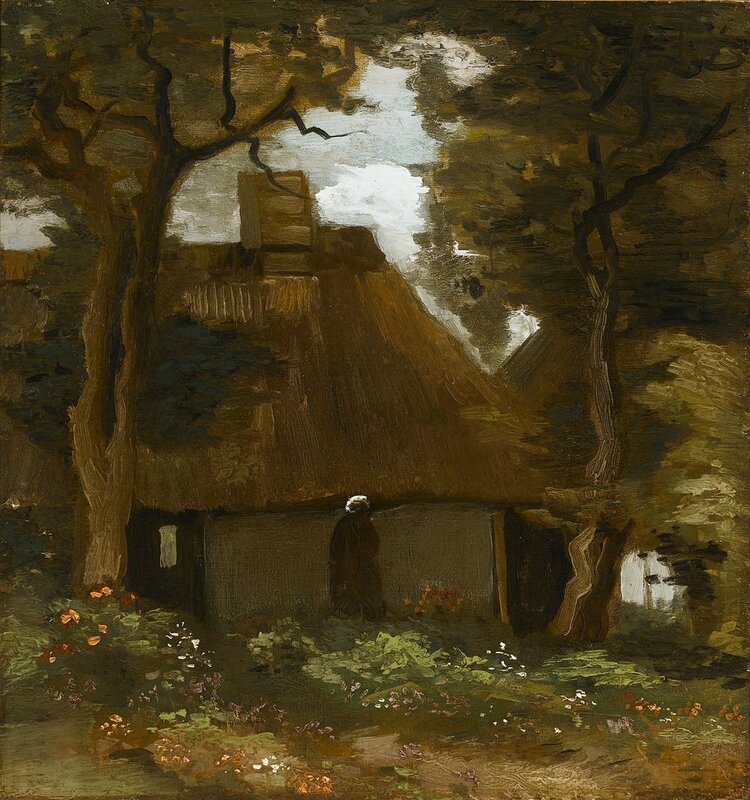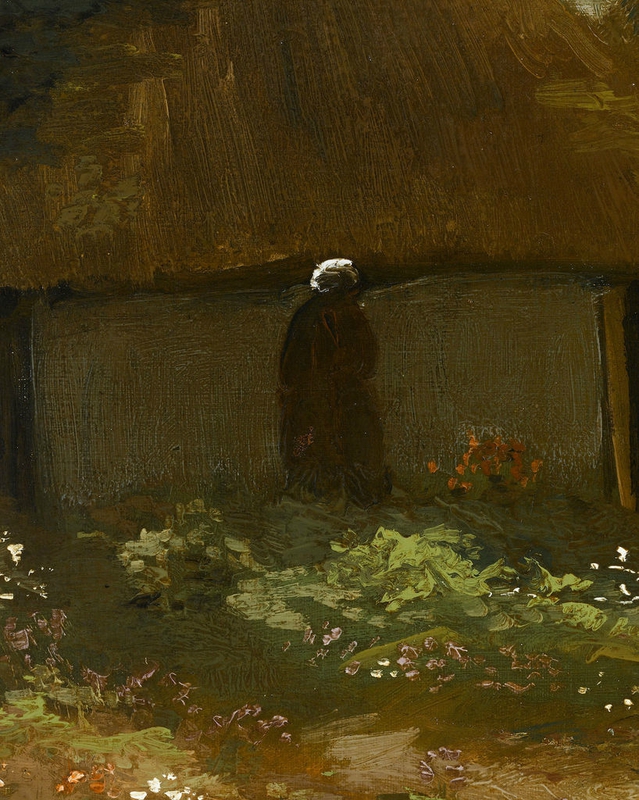Artistic Insight: La Chaumière sous les Arbres by Vincent van Gogh at M.S. Rau Antiques, New Orleans
Vincent van Gogh, La Chaumière sous les Arbres (The Cottage under the Trees), Circa 1885. Oil on canvas, Frame: 29 1/4" high x 28" wide. Canvas: 19 3/8" high x 18 3/4" wide. M.S. Rau Antiques, New Orleans.
NEW ORLEANS - The paintings of Vincent van Gogh rank amongst the most iconic in the world. Simply the mention of his name evokes thoughts of celebrated masterpieces created by one of history’s most important artists – masterpieces that, for the most part, are found only in the most prestigious museum collections.
Along with his captivating, distinctive aesthetic style, much of the appeal of his legendary paintings comes from the insight they give into the uncompromising, often troubled genius that is van Gogh. Once part of the Los Angeles County Museum of Art’s collection, La Chaumière sous les Arbres (The Cottage under the Trees), is not only visually compelling and marvelously composed, but it marks an important creative shift in his early output. His earliest recognized masterpiece, De Aardappeleters (The Potato Eaters), dates to 1885, the very same year as this immensely important oil on canvas.
La Chaumière sous les Arbres was created at a turning point in van Gogh’s career. He had spent the past two years in the southern Netherlands, and had little success with his art. His brother Théo was managing Goupil’s gallery and suggested adding brighter colors to his works, rather than the muted, earthy tones that permeated van Gogh’s palette. It was that suggestion that led to this highly emotive composition. With the artist’s hallmark intense brushwork, the peasant blends effortlessly into the landscape, contrasted by the bright sky and vivid wildflowers that act as jeweled beacons upon the canvas.
A Post-Impressionist tour-de-force, La Chaumière sous les Arbres provides a rare glimpse into the beginning of arguably the most immensely impactful and tragically short artistic career in modern history.
The authenticity of this work has been confirmed by the Van Gogh Museum and is accompanied by a certificate of authentication.
Provenance: F.W.R Wentges, Den Haag
Rene Gas, Paris
Private Collection, Philidelphia
William Woordward, New York
Richard Feigen, New York
Eugene V. Klein
LA County Museum of Art, Los Angeles
Private Collection
Exhibited: Van Gogh, Stadtisches Museum, Groningen 1904
The Richard L. Feigen Collection, A selection of painting, sculptures, and drawings, World House Galleries, New York, September - November 1957
Die Brücke und die Moderne 1904-1914, Bucerius Kunst Form Hamburg, October 2004 - January 2005.
This important work is mentioned in:
Onze Kunst: gei¨llustreerd maandschrift voor beeldende en decoratieve kunsten, 1904, page 3
Vincent van Gogh, 1942, J.B. de la Faille, no. 187 (illustrated)
van Gogh; Collection Prome´the´e, 1951, by J. Leymarie, pages 24, 98
The Richard L. Feigen Collection, a selection of painting, sculptures and drawings, 1957, Exhibition Catalogue, no. 3
The works of Vincent van Gogh, His paintings and drawings, 1970, J.B. de la Faille, no. 187 (illustrated)
The New Complete Van Gogh, Paintings, Drawings Sketches, 1996, J. Hulsker, page 180 (illustrated)
Vincent van Gogh, 1997, I. Walther and R. Metzger, page 110 (illustrated)
Die Bru¨cke und die moderne 1904-1914, 2004, Exhibition Catalogue, no.121 (illustrated in color)
Vincent van Gogh: Timeless Country - Modern City, 2011, C. Homburg, p. 11 (illustrated)
Definite parallels can be drawn between this and his earliest known work, De Aardappeleters (The Potato Eaters) in the use of earthy tones and Realist subject matter. Both of these works were completed in the same year, 1885. M.S. Rau Antiques, New Orleans

/https%3A%2F%2Fprofilepics.canalblog.com%2Fprofilepics%2F1%2F0%2F100183.jpg)
/https%3A%2F%2Fstorage.canalblog.com%2F03%2F02%2F119589%2F96711876_o.jpg)
/https%3A%2F%2Fstorage.canalblog.com%2F11%2F31%2F119589%2F94773502_o.jpg)
/https%3A%2F%2Fstorage.canalblog.com%2F20%2F83%2F119589%2F94772815_o.jpg)
/https%3A%2F%2Fstorage.canalblog.com%2F26%2F72%2F119589%2F75604929_o.jpg)
/https%3A%2F%2Fstorage.canalblog.com%2F59%2F60%2F119589%2F26458628_o.jpg)




/http%3A%2F%2Fstorage.canalblog.com%2F15%2F52%2F119589%2F129845078_o.jpg)
/http%3A%2F%2Fstorage.canalblog.com%2F25%2F77%2F119589%2F129711337_o.jpg)
/http%3A%2F%2Fstorage.canalblog.com%2F68%2F72%2F119589%2F129601013_o.jpg)
/http%3A%2F%2Fstorage.canalblog.com%2F84%2F73%2F119589%2F128782095_o.jpeg)